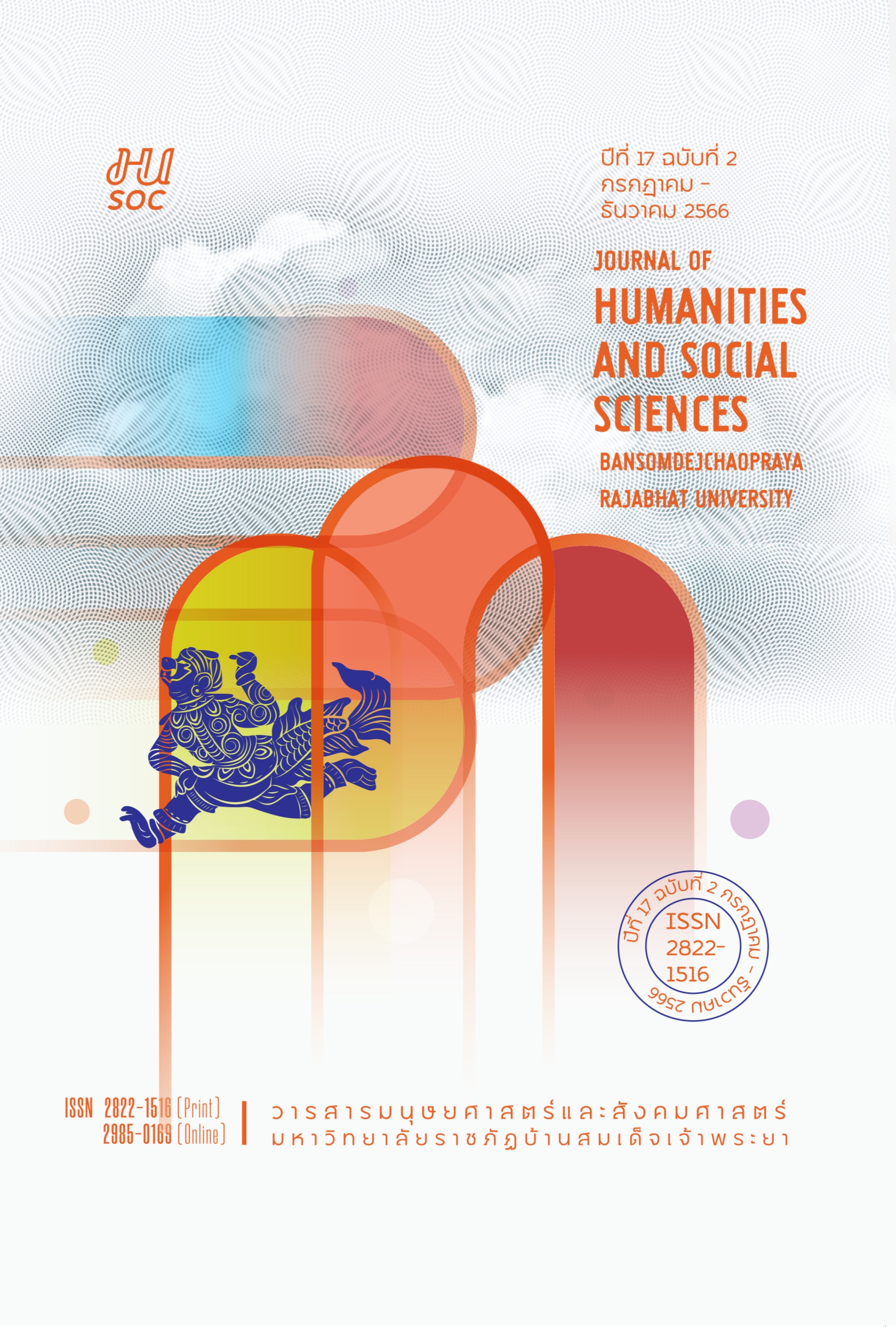การแสดงบทบาทข้ามเพศ: แนวคิดนอกกรอบเพศภาวะและปัจจัยหลักที่ส่งผลต่อการข้ามเพศ
คำสำคัญ:
การแสดงบทบาทข้ามเพศ, นาฏกรรม, เพศภาวะบทคัดย่อ
บทความวิจัยชิ้นนี้ มีวัตถุประสงค์เพื่อศึกษาการแสดงบทบาทข้ามเพศและการแสดงบทบาทข้ามเพศ ในนาฏกรรมไทยและเพื่อวิเคราะห์ถึงบริบทเพศภาวะที่เป็นปัจจัยส่งผลให้มีการแสดงบทบาทข้ามเพศ ผู้วิจัยใช้หลักวิจัยเชิงคุณภาพ ศึกษาข้อมูลจากเอกสาร งานวิจัย ภาพถ่ายและภาพเคลื่อนไหวที่เกี่ยวข้องประกอบกับข้อมูลการสัมภาษณ์ผู้ทรงคุณวุฒิ แล้วนำเสนอในรูปแบบของพรรณนาวิเคราะห์ ผลการศึกษา พบว่า การแสดงบทบาทข้ามเพศเป็นพื้นที่ของการแสดงออกนอกเหนือเพศภาวะของตัวนักแสดง มีปัจจัยขอบเขตทางสังคมมาเป็นตัวกำหนดทำให้เกิดการสวมบทบาทข้ามเพศ เมื่อเสร็จการแสดงแล้วนั้นก็กลับมาสู่เพศภาวะเดิม โดยมีปัจจัยดังนี้ 1) การให้อำนาจแก่เพศชาย 2) ทักษะการแสดง 3) ระบบการจัดการของคณะละคร 4) กฎมณเฑียรบาลการจำกัดพื้นที่ของเพศ
References
คมสันฐ หัวเมืองลาด. (นาฏศิลปินอาวุโส). สัมภาษณ์, 13 มกราคม 2565.
คมสันฐ หัวเมืองลาด. [ผู้ถ่ายภาพ]. (2565). นางละเวงวัณฬา. [ภาพถ่าย]. ผู้แต่ง.
ชานันท์ ยอดหงส์. (2563). “นายใน” สมัยรัชกาลที่ 6. (พิมพ์ครั้งที่ 8). มติชน.
ธนิต อยู่โพธิ์. (2539). โขน. องค์การค้าของคุรุสภา.
ดำรงราชานุภาพ, สมเด็จพระเจ้าบรมวงศ์เธอกรมพระยา. (2464). ตำนานเรื่องลครอิเหนา. โรงพิมพ์ไทย.
ดำรงราชานุภาพ, สมเด็จพระเจ้าบรมวงศ์เธอกรมพระยา.. (2508). ตำนานละครอิเหนา. คลังวิทยา.
ภัคภรจันท์ เกษมศรี. (2562). สมุดภาพสยามเรเนซองส์: ความทรงจำแห่งกรุงรัตนโกสินทร์ เล่ม 2. สยาม เรเนซองส์.
ศุภชัย จันทร์สุวรรณ์. (2564). นางสีดา (รองศาสตราจารย์ ดร. ศุภชัย จันทร์สุวรรณ์). [ภาพถ่าย]. ผู้แต่ง.
ศุภชัย จันทร์สุวรรณ์. (ศิลปินแห่งชาติ สาขาศิลปะและการแสดง (นาฏศิลป์)). สัมภาษณ์, 20 สิงหาคม 2564.
ศูนย์มานุษยวิทยาสิรินธร (องค์กรมหาชน). (2563). สภาวะข้ามเพศในวัฒนธรรมประเพณีของอินโดนีเซีย. สืบค้น 8 สิงหาคม 2563. https://channel.sac.or.th/th/vdo/detail/MEFsbk9oZ1NIMk4rOGhTSkUveVU0UT09
สหะโรจน์ กิตติมหาเจริญ. (2555). โลกของนางยี่เกชายยุคก่อนและหลังจอมพล ป. พิบูลสงคราม. ศูนย์มานุษยวิทยาสิรินธร (องค์กรมหาชน).
สุจิตต์ วงษ์เทศ. (2551). ข้าวปลาอาหารไทย ทำไม? มาจากไหน: กองทุนเผยแพร่ความรู้สู่สาธารณะ. สืบค้น 20 สิงหาคม 2563. https://channel.sac.or.th/th/website/video/detail_news/2610
Vogue Thailand. (2565). ‘DRAG’ จากวัฒนธรรมบันเทิงเช็ก สเปียร์ สู่เครื่องมือเรียกร้องความเท่าเทียมทางเพศ. สืบค้น 10 ตุลาคม 2565. https://www.vogue.co.th/fashion/article/draghistory101
Hughes-Freeland, F. (2008). Embodied Communities: Dance Traditions and Change in Java. Volume 2 of Dance and performance studies. Berghahn Books.
Moncrieff, M. & Lienard, P. (2017). A Natural History of the Drag Queen Phenomenon. Retrieved July 27, 2020. https://journals.sagepub.com/doi/full/10.1177/1474704917707591
Mrazek, J. (2005). ‘Masks and selves in contemporary Java: the dances of Didik Nini Thowok’. Journal of Southeast Asia Studies. 36(2), 249-279.
Wang, Q. (2015). Research on Male Dan in Chinese Peking Opera and Castrato in Italian Opera. International Conference on Economics, Social Science, Arts, Education and Management Engineering (ESSAEME 2015). (pp. 64-68). Atlantis Press.
Downloads
เผยแพร่แล้ว
How to Cite
ฉบับ
บท
License
Copyright (c) 2023 คณะมนุษยศาสตร์และสังคมศาสตร์ มหาวิทยาลัยราชภัฏบ้านสมเด็จเจ้าพระยา

This work is licensed under a Creative Commons Attribution-NonCommercial-NoDerivatives 4.0 International License.



